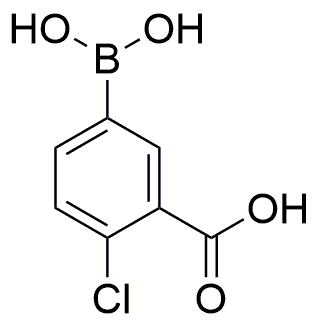3-Carboxy-4-chlorophenylboronic acid is widely utilized in research focused on:
- Pharmaceutical Development: This compound plays a crucial role in synthesizing various pharmaceuticals, particularly in the development of anti-cancer agents. Its ability to form stable complexes with biomolecules enhances drug efficacy.
- Organic Synthesis: It serves as a versatile building block in organic chemistry, allowing researchers to create complex molecules through Suzuki coupling reactions, which are essential in producing fine chemicals and agrochemicals.
- Bioconjugation: The compound is used in bioconjugation processes, linking biomolecules for targeted drug delivery systems. This application is vital in improving the specificity and effectiveness of therapeutic agents.
- Sensor Technology: Its properties make it suitable for developing sensors that detect specific biomolecules, aiding in diagnostics and environmental monitoring, which is crucial for healthcare and safety applications.
- Material Science: The compound is also explored in creating advanced materials, such as polymers with enhanced properties, which can be applied in various industries, including electronics and packaging.
General Information
Properties
Safety and Regulations
Applications
3-Carboxy-4-chlorophenylboronic acid is widely utilized in research focused on:
- Pharmaceutical Development: This compound plays a crucial role in synthesizing various pharmaceuticals, particularly in the development of anti-cancer agents. Its ability to form stable complexes with biomolecules enhances drug efficacy.
- Organic Synthesis: It serves as a versatile building block in organic chemistry, allowing researchers to create complex molecules through Suzuki coupling reactions, which are essential in producing fine chemicals and agrochemicals.
- Bioconjugation: The compound is used in bioconjugation processes, linking biomolecules for targeted drug delivery systems. This application is vital in improving the specificity and effectiveness of therapeutic agents.
- Sensor Technology: Its properties make it suitable for developing sensors that detect specific biomolecules, aiding in diagnostics and environmental monitoring, which is crucial for healthcare and safety applications.
- Material Science: The compound is also explored in creating advanced materials, such as polymers with enhanced properties, which can be applied in various industries, including electronics and packaging.
Documents
Safety Data Sheets (SDS)
The SDS provides comprehensive safety information on handling, storage, and disposal of the product.
Product Specification (PS)
The PS provides a comprehensive breakdown of the product’s properties, including chemical composition, physical state, purity, and storage requirements. It also details acceptable quality ranges and the product's intended applications.
Certificates of Analysis (COA)
Search for Certificates of Analysis (COA) by entering the products Lot Number. Lot and Batch Numbers can be found on a product’s label following the words ‘Lot’ or ‘Batch’.
*Catalog Number
*Lot Number
Certificates Of Origin (COO)
This COO confirms the country where the product was manufactured, and also details the materials and components used in it and whether it is derived from natural, synthetic, or other specific sources. This certificate may be required for customs, trade, and regulatory compliance.
*Catalog Number
*Lot Number
Safety Data Sheets (SDS)
The SDS provides comprehensive safety information on handling, storage, and disposal of the product.
DownloadProduct Specification (PS)
The PS provides a comprehensive breakdown of the product’s properties, including chemical composition, physical state, purity, and storage requirements. It also details acceptable quality ranges and the product's intended applications.
DownloadCertificates of Analysis (COA)
Search for Certificates of Analysis (COA) by entering the products Lot Number. Lot and Batch Numbers can be found on a product’s label following the words ‘Lot’ or ‘Batch’.
*Catalog Number
*Lot Number
Certificates Of Origin (COO)
This COO confirms the country where the product was manufactured, and also details the materials and components used in it and whether it is derived from natural, synthetic, or other specific sources. This certificate may be required for customs, trade, and regulatory compliance.


